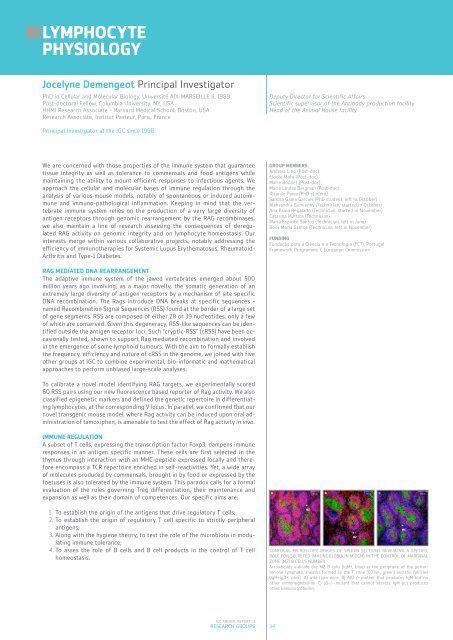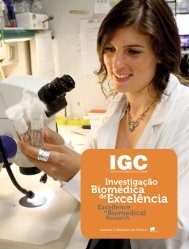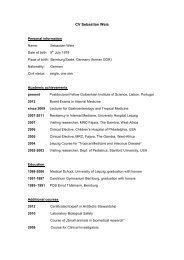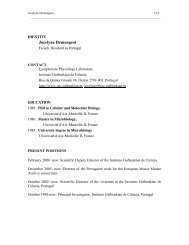organisation - the Instituto Gulbenkian de Ciência
organisation - the Instituto Gulbenkian de Ciência
organisation - the Instituto Gulbenkian de Ciência
- No tags were found...
Create successful ePaper yourself
Turn your PDF publications into a flip-book with our unique Google optimized e-Paper software.
LYMPHOCYTE<br />
PHYSIOLOGY<br />
Jocelyne Demengeot Principal Investigator<br />
PhD in Cellular and Molecular Biology, Université AIX-MARSEILLE II, 1989<br />
Post-doctoral Fellow, Columbia University, NY, USA<br />
HHMI Research Associate - Harvard Medical School, Boston, USA<br />
Research Associate, Institut Pasteur, Paris, France<br />
Deputy Director for Scientific Affairs<br />
Scientific supervisor of <strong>the</strong> Antibody production facility<br />
Head of <strong>the</strong> Animal House facility<br />
Principal Investigator at <strong>the</strong> IGC since 1998<br />
We are concerned with those properties of <strong>the</strong> immune system that guarantee<br />
tissue integrity as well as tolerance to commensals and food antigens while<br />
maintaining <strong>the</strong> ability to mount efficient responses to infectious agents. We<br />
approach <strong>the</strong> cellular and molecular bases of immune regulation through <strong>the</strong><br />
analysis of various mouse mo<strong>de</strong>ls, notably of spontaneous or induced autoimmune<br />
and immuno-pathological inflammation. Keeping in mind that <strong>the</strong> vertebrate<br />
immune system relies on <strong>the</strong> production of a very large diversity of<br />
antigen receptors through genomic rearrangement by <strong>the</strong> RAG recombinases,<br />
we also maintain a line of research assessing <strong>the</strong> consequences of <strong>de</strong>regulated<br />
RAG activity on genomic integrity and on lymphocyte homeostasis. Our<br />
interests merge within various collaborative projects, notably addressing <strong>the</strong><br />
efficiency of immuno<strong>the</strong>rapies for Systemic Lupus Ery<strong>the</strong>matosus, Rheumatoid-<br />
Arthritis and Type-1 Diabetes.<br />
GROUP MEMBERS<br />
Andreia Lino (Post-doc)<br />
Elodie Mohr (Post-doc)<br />
Marie Bonnet (Post-doc)<br />
Marie Louise Bergman (Post-doc)<br />
Ricardo Paiva (PhD stu<strong>de</strong>nt)<br />
Sandra Gama Garcies (PhD stu<strong>de</strong>nt, left in October)<br />
Aleksandra Gumienny (Technician, started in October)<br />
Ana Paula Regalado (Technician, started in November)<br />
Catarina Martins (Technician)<br />
Maria Espírito Santos (Technician, left in June)<br />
Rosa Maria Santos (Technician, left in November)<br />
FUNDING<br />
Fundação para a Ciência e a Tecnologia (FCT), Portugal<br />
Framework Programme 7, European Commission<br />
RAG MEDIATED DNA REARRANGEMENT<br />
The adaptive immune system of <strong>the</strong> jawed vertebrates emerged about 500<br />
million years ago involving, as a major novelty, <strong>the</strong> somatic generation of an<br />
extremely large diversity of antigen receptors by a mechanism of site specific<br />
DNA recombination. The Rags introduce DNA breaks at specific sequences -<br />
named Recombination Signal Sequences (RSS) found at <strong>the</strong> bor<strong>de</strong>r of a large set<br />
of gene segments. RSS are composed of ei<strong>the</strong>r 28 or 39 nucleoti<strong>de</strong>s, only a few<br />
of which are conserved. Given this <strong>de</strong>generacy, RSS-like sequences can be i<strong>de</strong>ntified<br />
outsi<strong>de</strong> <strong>the</strong> antigen receptor loci. Such “cryptic-RSS” (cRSS) have been occasionally<br />
tested, shown to support Rag mediated recombination and involved<br />
in <strong>the</strong> emergence of some lymphoid tumours. With <strong>the</strong> aim to formally establish<br />
<strong>the</strong> frequency, efficiency and nature of cRSS in <strong>the</strong> genome, we joined with five<br />
o<strong>the</strong>r groups at IGC to combine experimental, bio-informatic and ma<strong>the</strong>matical<br />
approaches to perform unbiased large-scale analyses.<br />
To calibrate a novel mo<strong>de</strong>l i<strong>de</strong>ntifying RAG targets, we experimentally scored<br />
60 RSS pairs using our new fluorescence based reporter of Rag activity. We also<br />
classified epigenetic markers and <strong>de</strong>fined <strong>the</strong> genetic repertoire in differentiating<br />
lymphocytes, at <strong>the</strong> corresponding V locus. In parallel, we confirmed that our<br />
novel transgenic mouse mo<strong>de</strong>l, where Rag activity can be induced upon oral administration<br />
of tamoxiphen, is amenable to test <strong>the</strong> effect of Rag activity in vivo.<br />
IMMUNE REGULATION<br />
A subset of T cells, expressing <strong>the</strong> transcription factor Foxp3, dampens immune<br />
responses in an antigen specific manner. These cells are first selected in <strong>the</strong><br />
thymus through interaction with an MHC-pepti<strong>de</strong> expressed locally and <strong>the</strong>refore<br />
encompass a TCR repertoire enriched in self-reactivities. Yet, a wi<strong>de</strong> array<br />
of molecules produced by commensals, brought in by food or expressed by <strong>the</strong><br />
foetuses is also tolerated by <strong>the</strong> immune system. This paradox calls for a formal<br />
evaluation of <strong>the</strong> rules governing Treg differentiation, <strong>the</strong>ir maintenance and<br />
expansion as well as <strong>the</strong>ir domain of competences. Our specific aims are:<br />
1. To establish <strong>the</strong> origin of <strong>the</strong> antigens that drive regulatory T cells;<br />
2. To establish <strong>the</strong> origin of regulatory T cell specific to strictly peripheral<br />
antigens;<br />
3. Along with <strong>the</strong> hygiene <strong>the</strong>ory, to test <strong>the</strong> role of <strong>the</strong> microbiota in modulating<br />
immune tolerance;<br />
4. To asses <strong>the</strong> role of B cells and B cell products in <strong>the</strong> control of T cell<br />
homeostasis.<br />
CONFOCAL MICROSCOPY IMAGES OF SPLEEN SECTIONS REVEALING A SPECIFIC<br />
ROLE FOR SECRETED IMMUNOGLOBULIN M (IGM) IN THE CONTROL OF MARGINAL<br />
ZONE (MZ) B CELLS NUMBER.<br />
Arrowheads indicate <strong>the</strong> MZ B cells (IgM+, blue) at <strong>the</strong> periphery of <strong>the</strong> periarteriolar<br />
lymphatic sheaths formed by <strong>the</strong> T zone (CD3e+, green) and <strong>the</strong> follicles<br />
(IgM+IgD+, pink). A) wild-type mice. B) AID-/- mutant that produces IgM but no<br />
o<strong>the</strong>r immunoglobulins. C) µS-/- mutant that cannot secrete IgM but produces<br />
o<strong>the</strong>r immunoglobulins.<br />
IGC ANNUAL REPORT ‘11<br />
RESEARCH GROUPS<br />
34






